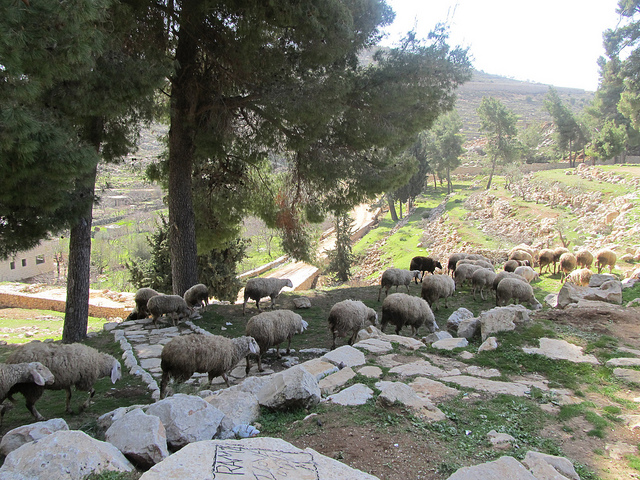Delayed post from 23 February 2016
As we walk through silent, little Bethlehem, I can still hear the three wise men roaming through these narrow streets with their donkeys’ rhythmical clack of hooves fading into the flagrant symphony of commerce and daily affairs that takes place in Palestinian suqs (markets). If anything elevates Bet Sahour over the archeological sites we have visited so far it is the liveliness and musicality that hardly occurs within the granite walls of temples erected for the sun-baked gods of antiquity. The schools, churches, mosques, food shops and other ‘normal’ businesses fill the town with an air of that everyday festivity that is characteristic of small, picturesque towns. And it is this ‘everydayness’ that especially brings to life the miraculous events of old that occurred in this area: there are still flocks of sheep placidly grazing in Shepherds Field where the angels first announced Jesus’ birth, there is still a manger in the hypothetical ‘stable’ where baby Jesus was born, there is still an olive tree where wee, faithful Zacheus climbed just to take a glance at the famed Jesus in his ministry. The divine merging of ancient and contemporary life vitalizes the area and adds an entirely new dimension to Sunday school stories. Proclaiming clearly and loudly the existence of a people, these ‘temples and ruins’ of old have managed to preserve their ‘colors’ nearly to perfection.
What has also been preserved nearly to perfection are the ‘vestiges’ of a 50-year-old martial occupation in Palestine. Hebron, the anointment place of merciful King David, withstands today the strength of Israeli military control. Embedded in Area C (West Bank territory under Israeli Civic and Martial Law), Hebron is a crystal clear example of a slow but steady socioeconomic strangulation. This town is surrounded by Israeli settlements, which are illegal Jewish colonies within Palestinian territory, and therefore experiences a deflating desolation that makes business next to impossible. Yet enterprising micro-businesspeople refuse to leave their homes and refuse to venture into more fertile markets abroad by raising their flag of resistance: to exist is to resist. In silent, little Bethlehem there is still that 2000-year-old hope for peace on earth and good will to women and men, but, since peace belongs to those that can keep it, to Bethlehemites peace takes the shape of a 13-metre-high concrete wall and numerous checkpoints where Palestinians sometimes wait for over three hours to cross in and out in order to get to their daily activities. Yet workers, university students, mothers, fathers patiently wait in these never ending lines in order to build their families, their nation, all while raising their resistance flag: to exist is to resist. The monumental temples and obelisks erected to appease the irate, ever-scowling gods evidently did not suffice in this part of the world because the lords of war are still collecting their entitled share of suffering and despair. And as we move through these people’s struggle, with no more help to offer than our condolence and companionship, we raise their flag of resistance: to exist is to resist.
We planted grape vines at Mr. Daoud Nasser’s 100-acre property. His grandfather owned the property since the Ottoman occupation, and unlike most Palestinians, he possessed documents to legitimize this ownership. The Nasser family has been farming the land since then, passing it on from generation to generation, but as settlements encroach around his property, this generational continuity has come under threat. After the overnight destruction of his 1,500 olive trees, numerous threats, and countless legal quarrels, Mr. Nasser still remains faithful to the struggle: to exist is to resist. Today he runs the Tent of Nations, an organization responsible for proactively building a better future for Palestine by strengthening the productive sector of the nation. The resistance, according to Mr. Nasser, must be built from the ground up emphasizing the role of individuals to achieve the liberation and sustenance of the Palestinian State. This idealistic and perhaps futile hope is what strengthens an entire generation that powers through a decade-long national endeavor. This reality-defying ideal is what inspires an entire country that refuses to leave the ancestral homelands clinging to that 70-year-old maxim: to exist is to resist. And as we prepare to set out, let us say a prayer, of hands and not of mouth, to work for a day when the mass robbery of lands, the 13-metre-high apartheid walls, the excruciating checkpoints, and all the other vast and varied forms of oppression–here and everywhere–will seem as ancient and Ozymandian as the few ‘pebbles’ remaining for the rock-silent gods of power whose worship-filled reigns crumbled long ago with the resounding liberation shout: to Exist is to Resist!
-Diego Barahona
20 March 2016
Charlie Good compiled a video recording of stories from independent travel last week. It can be found on YouTube at https://youtu.be/R_Iqu6RqbEA.

